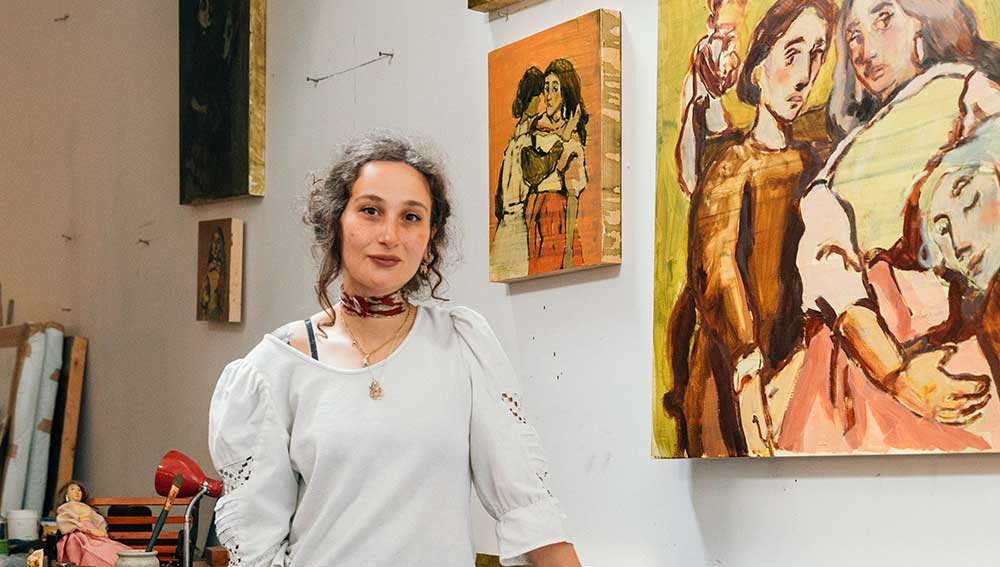
Liorah Tchiprout in her studio, 2024. Courtesy of the artist and Pippy Houldsworth Gallery, London. Photo: Sam Hylton.
by JOE LLOYD
Liorah Tchiprout’s paintings feel simultaneously contemporary and very old. This may be because of their dusky backgrounds, which give little away, and the plain, difficult-to-place clothing that Tchiprout’s subjects wear. It may be because of the warmness of her colours, which feel almost worn by the passage of years. And it may also be because of the spectres of Tchiprout’s artistic heroes: Käthe Kollwitz, Paula Modersohn-Becker, Léon Spilliaert and John Singer Sargent. But her figures are timeless in another sense, as if they are removed from the passing of time, or folkloric figures that appear in altered guises over time.
This may be because they are not humans but dolls. Tchiprout creates miniature simulacrums of humans, then paints them with the delicacy that other painters ascribe to living subjects. “We are caught,” writes art historian Dr Richard Davey, “pulled in, intrigued, held captive in narratives conveyed by a tilt of the head, a half look away, an expressive arm raised in silent conversation, a demure downward gaze, the silent body language that needs no words.” The dolls’ expressions suggest that they are characters in numerous off-panel stories. Tchiprout is a voracious reader. Her interest in dolls is informed by Paul Gallico’s Love of Seven Dolls (1954) and Philip Roth’s Sabbath’s Theater (1995), which alternatively present dolls as objects of devotions and bringers of chaos.
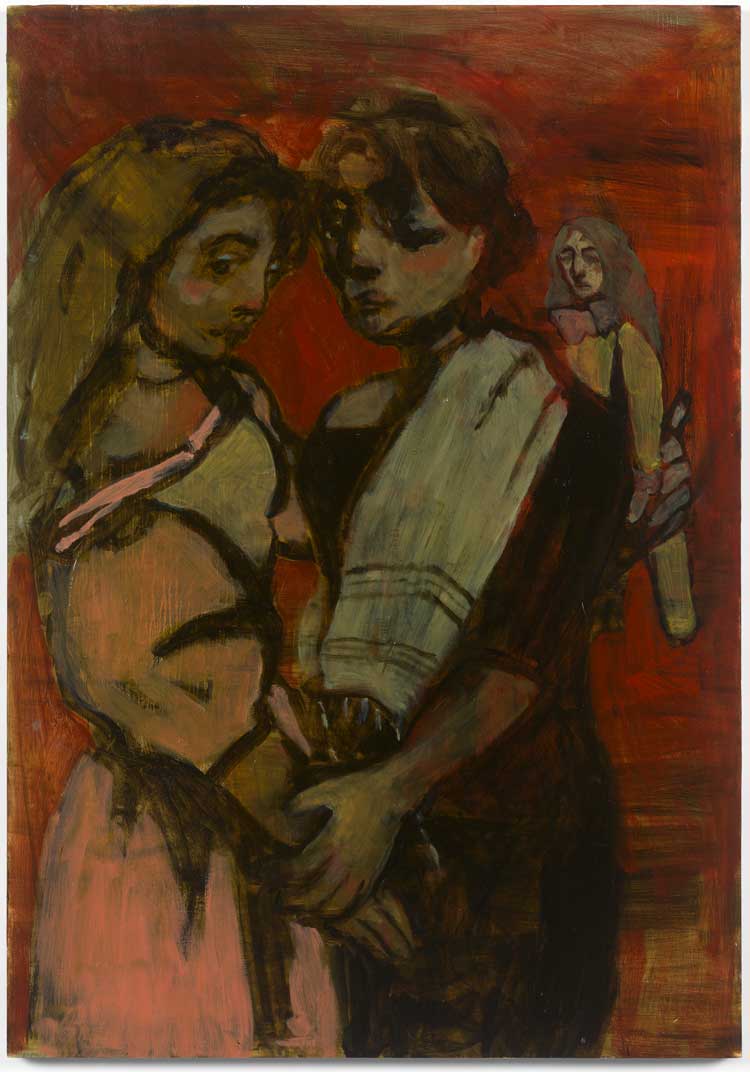
Liorah Tchiprout. He made us and we are his, 2024. Oil on panel, 100 x 70 cm (39 ¼ x 27 ½ in). Courtesy the artist and Pippy Houldsworth Gallery, London. © Liorah Tchiprout 2024. Photo: Todd-White Art Photography.
Tchiprout, who is Jewish and keen to convey the beauty of her culture, is particularly inspired by female Yiddish poets. Her new exhibition at Pippy Houldsworth Gallery, I Love the Flames, But Not the Embers, is titled after a poem referenced in Miriam Karpilove’s epistolary 1911 novel Judith. “The feeling of that novel,” Tchiprout explains, “is such desperation – ‘I was waiting for you at the port, you didn’t turn up. Where are you, what’s happening?’ – this constant push-and-pull. I’m interested in that as a concept in my work.”
Tchiprout does not take her success for granted. She studied fine art printmaking at the University of Brighton before taking an MA at Camberwell College of Arts. Until recently she worked in a print studio, helping to create editions for other artists while pursuing her own prints in her spare time. During lockdown, she started creating miniature paintings, which she began selling through social media. Interest grew organically from this. In 2023, she won the Sunny Dupree Family Award for a Woman Artist at the Royal Academy of Arts Summer Exhibition.
Last December, she opened her first painting exhibition at Marlborough, the storied Mayfair gallery that closed this summer after almost 80 years. “I got the call [about the closure],” recalls Tchiprout, “and I was just lying on the grass thinking: ‘Oh shit.’ Because we had some really exciting plans.” She worried her career would end just as it had started. Soon after, Pippy Houldsworth stepped in. Earlier this year, she had a display of her dolls there. “They’re very supportive,” says Tchiprout. “I’m really, really lucky to be enabled by galleries the way I am now. It’s really important to feel someone has your back and your best interests.”
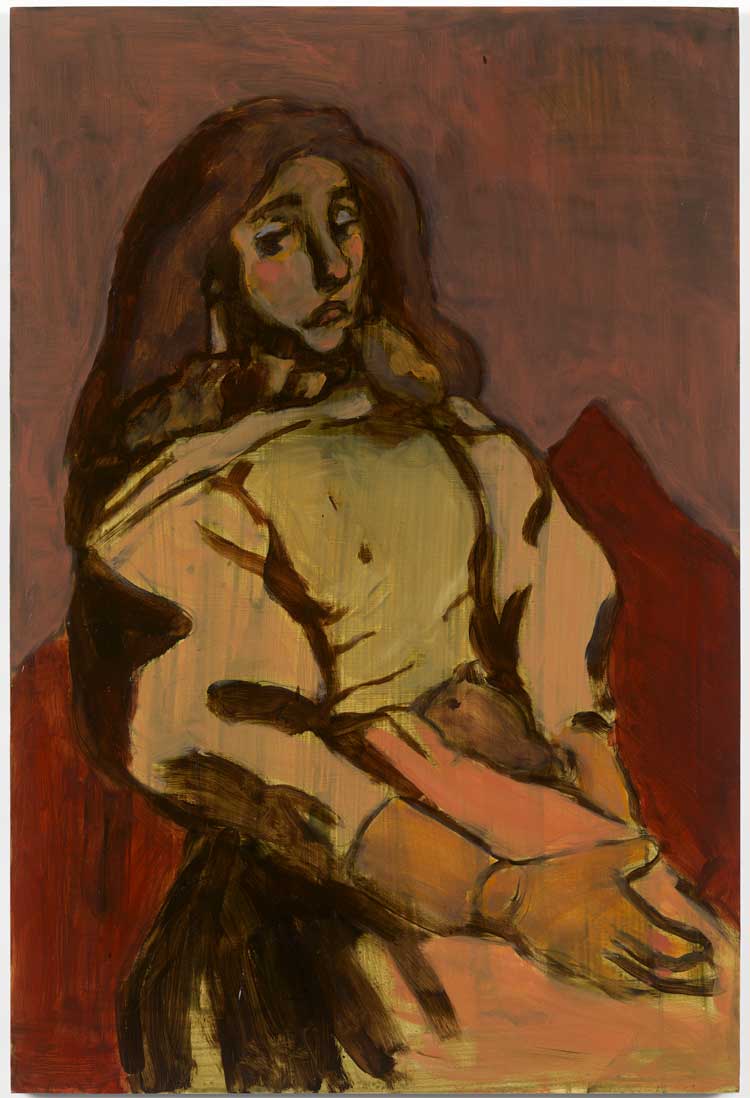
Liorah Tchiprout. I just nibble and gnaw because that is the way that I'm made, 2024. Oil on panel, 90 x 61 cm (35 ½ x 24 in). Courtesy the artist and Pippy Houldsworth Gallery, London. © Liorah Tchiprout 2024. Photo: Todd-White Art Photography.
Studio International met Tchiprout in her north London live-in studio, an ex-industrial unit awash with art, homemade candles and miniature objects. “People like to give me little things,” she says. Her current dolls dwell atop a portfolio drawer, with brushes, paints and miniature furniture; their retired sisters live atop a cabinet. A vintage Hunter Penrose Littlejohn printing press, which Tchiprout bought with her RA prize, holds pride of place. She paints beneath a high window, which casts natural light on her canvases.
Ahead of the exhibition, Studio International talked to Tchiprout about the status of printmaking, transposing literature to art and the world of lies.
Joe Lloyd: I see you have a poster on your wall of Léon Spilliaert’s Woman at the Shoreline (1910), from the 2020 Royal Academy exhibition.
Liorah Tchiprout: That show just moved me so much that I was like ‘I need the poster!’ I need to see it in my peripheral vision for ever. So that’s why I’ve got one.
Something I really love about Spilliaert is that – there’s Spilliaert and Ensor in Ostend at the same time, but then [collector and gallerist] Mattias Vendelmans introduced me to Alice Frey – she’s unbelievable, amazing. She was a friend of Ensor, but he was a lot older, a bit more like a mentor. But the way that there were these three artists in the city … What was in the water? One of my favourite artists, Marcelle Hanselaar, is Dutch. She’s made quite a big series on returning to the North Sea, and a lot of work that’s to do with the death of her sister, that’s connected to Spilliaert.
With Spilliaert, you can say: “Oh, it’s a self-portrait, it’s a landscape, it’s a scene.” And it is. But it’s also a whole colour sensibility, it’s a whole world, and it’s a whole world of feeling.
You know when you’re a child or very young teenager when you read a novel, and you realise that a novel is like a vessel for ideas, not just a story. And it kind of just blows your mind. Your brain just expands. I think that he’s one of those artists that’s a gateway into understanding what pictures are.
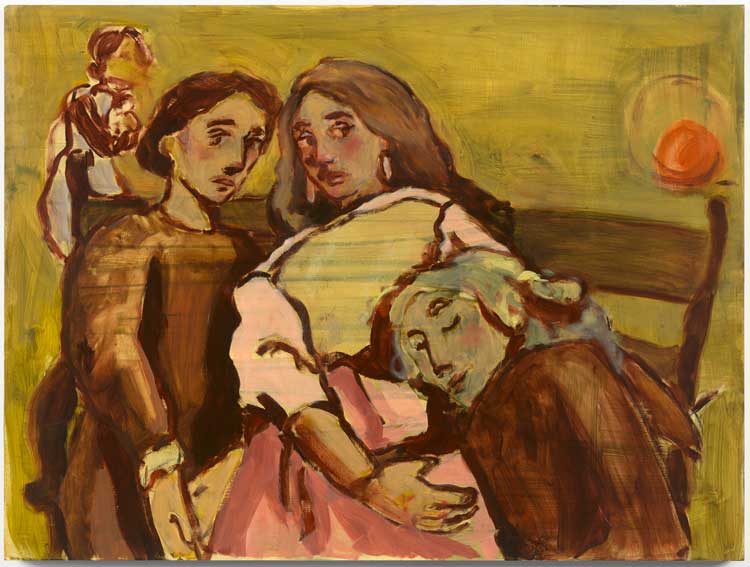
Liorah Tchiprout. I know where I stand with the skylarks, 2024. Oil on panel, 91 x 122 cm (35 ¾ x 48 in). Courtesy the artist and Pippy Houldsworth Gallery, London. © Liorah Tchiprout 2024. Photo: Todd-White Art Photography.
JL: You started out as a printmaker, a medium that is sometimes neglected in contemporary art.
LT: Print is often sidelined. I used to work in editioning. Often high-profile galleries will work with an editioning house. But when you make your own print, it’s kind of a strange gap that maybe you fall through.
For me, the way that a print exists as a multiple has such a philosophical interest. I read an essay that talks about how the matrix of a print is unlike that in a painting or drawing. In those, you make a mark on something and then it’s there. With print, the paper is a relief of the matrix. So where does the work exist? Especially with the mirroring, the way the images are inverted. They exist in a mirror world.
So, philosophically, there’s a lot in print. If an etching is in an edition of 14, there’s 14 of them that go off and that are living in different environments of their own. Which is kind of odd, because you think of the shared image which is so ubiquitous with the lives that we live now with social media, you think that as very removed from fine art, but actually they’re very connected. The print is the bridge in between.
JL: What drew you to choose printmaking as your initial medium?
LT: When I was 17, I got an interview for Slade with some paintings and drawings I’d made. I didn’t get in. I was devastated. Afterwards, I was working at an art fair and met Colin Gale, who co-founded and runs Artichoke Print Workshop. And I spent a lot of time – I should have been working on a fire exit or something – just making prints. It was so amazing. So, I started making prints in the studio, and they helped me make a portfolio to apply to study fine-art printmaking.
It also allowed me to find a formalisation of drawing that wasn’t terrifying. Because I really think painting is terrifying! I’m really grateful that I started painting seriously so much later. I think that’s a really good thing.
JT: Because so much can go wrong?
LT: Yes, and – maybe this is controversial – I don’t know if a bad print is as bad as a bad painting. It’s a bit like singing with a jazz band. Even if your singing is not that great, the band is great. Whereas painting is like The Voice.
But, also, I didn’t come from a background where I knew any artists, or knew anything about that world. And I didn’t have the conception that you could have a career as an artist. My family were very supportive, although also probably quite concerned, looking back. So, I thought: “Well, if I can print etchings really well, then I can work, then I can have a job that’s not in a bar, something which is still connected to art.”
There’s an academic named Paul Coldwell who writes about print. He also printed a lot with Paula Rego. So there was a pull factor to that idea of being adjacent to artists and enabling them to make their work. Obviously, my favourite thing is making my own work. But I think if you don’t have people telling you that, you envisage that as possible, you think of that as something that other people do.
And the received wisdom is that there are certain places that you have to study, and that is the gold star which will enable you to continue. I thought that there was a train I was supposed to be on. I missed it, but I can enable other artists.
JT: So, in a sense, you feel your practice has developed aside from the mainstream, the main networks?
LT: I think I’ve been a bit more like a lone ranger, instead of coming out of an art school where you have this group, and maybe there are techniques that can enable you to make something which looks like a very polished practice on the surface. I think you need to do some absolutely terrible work, never imagining anyone will actually look at it all, in order to come out on the other end making something that will sustain you intellectually. You can go to a show of graduates from really prestigious art schools and be impressed, but you also don’t feel very much. Then you could be in a cafe, and someone has put some work on a wall, and even if it’s not in proportion or something, you feel something.
I am grateful, though, because I’ve met many of the artists who really inform my work and inspire me on the way. Many have become good friends. And there have been a lot of people who believed in my work before I understood it. A huge one is John Phillips, who was the director of London Print Studio, formerly Paddington Printshop. He would just call me up and say: “Oh, this artist is in the studio, you should come and meet them.” I met him because I was doing an internship there, which was mainly cleaning screens, but he really supported me and believed in what I was doing. Most of the furniture here are gifts from him. People have given me huge amounts of material.
So, I feel like there’s the alternative education you have where people see that you really care and you really believe in what you’re doing, and genuinely want to help you.
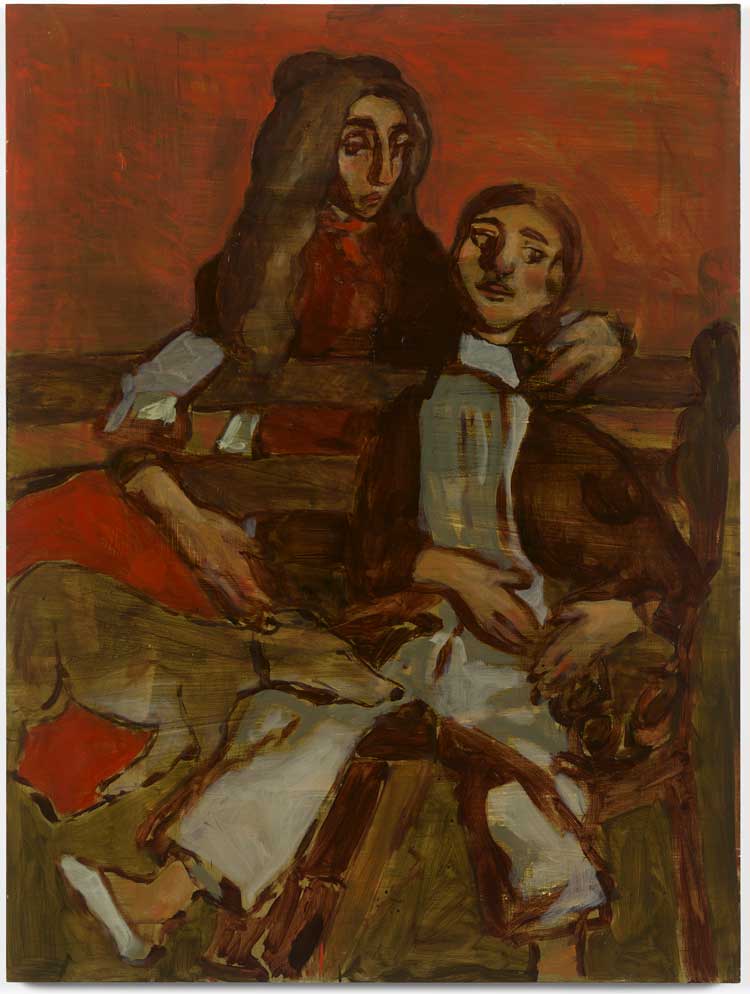
Liorah Tchiprout. Not everyone comes here to celebrate, 2024. Oil on panel, 122 x 91 cm (48 x 35 ¾ in). Courtesy the artist and Pippy Houldsworth Gallery, London. © Liorah Tchiprout 2024. Photo: Todd-White Art Photography.
JL: How did you balance your own work with your day job in editioning?
LT: I didn’t imagine that my work would be received in any capacity. I wasn’t really sad about that because I never thought that at the beginning. I just thought: “You go to work, and then you go home, and you make a sandwich, and then you do your drawings, and that’s fulfilling.”
JL: When did you start exhibiting your own works?
LT: It was very strange. I lost my job in lockdown and I got a job as a station cleaner. Then I got Covid from that. I was starting to get some recognition from open-call stuff. But then I started painting little works. And people started buying them through the Artist Support Pledge, just with a hashtag. I would put a painting on, and someone would buy it. I’d do another one, and someone would buy it. It was really crazy for me.
When lockdown started to ease, I was picking up bits of work like life-modelling. And then eventually people would ask me if I was available do other jobs and I realised I didn’t have time. Because suddenly there was enough interest that I could sell my work. This has made painting more nerve-racking, because since I started painting I’ve been living from selling paintings. It’s really scary, because you don’t want to sell things that you know aren’t meeting a level of integrity.
JL: What motivated your shift towards this nerve-racking medium?
LT: I think it was because I couldn’t go to the print room. I’m a very slow learner. I get quite stuck in the way of doing something, which is why it’s good that I can work at pace, because then at least things are moving forward even if you’re spending a lot of time going over one work. Lockdown forced me to think: “OK, well, how about I start making paintings?” My first paintings were very small, kind of postcard-sized works. And it took me quite a long time to build to like larger paintings.
JL: Looking around at your paintings, I notice that a lot of them have a plain, dusky-coloured background, like Venetian portraits. What sort of space do they exist in?
LT: It’s a psychological space. I would like them to exist in more of an interior or a landscape, but like I said about slow learning, I’m getting there but very slowly. You know I think with Spilliaert it is about colour creating feeling, and shapes creating feeling. Especially when the painting doesn’t work, painting over it and then having the new painting on the top, and then there’s these sort of shapes that come through. And also being the kind of pace that doesn’t work, there’s this kind of [mimes frenetic brushwork] go, go, go, which leads to something that’s very gestural.
JL: Do you feel your paintings and prints all exist in the same world, so to speak?
LT: I think they’re all together. A lot of the paintings that are going to be in the gallery are group pieces. There’s a lot more interaction between the figures. I like the idea of them comforting each other. But they are definitely in the same universe. That’s a strange thing. One of my favourite artists is John Singer Sargent – legend. And the way you look at his paintings and they’re so real, they’re more real than life, but of course if you get too close to it and look on the side, it’s just pigment and paint mixed together on a piece of fabric. It’s an illusion.
There’s an idea of Kabbalah that everything we see is the kingdom of lies. It’s a cloak and underneath it is the divine. We see the covering. And I think there’s something of this. Where do my dolls exist – on a table in my studio, surrounded by junk. I like the idea that this is a veneer, layers of lies. But that’s where they all exist.
I am also, as a side note, very obsessed with his portraits specifically of Jewish women, to see people who look like my friends or my sisters painted in this way. They look like Jewish people. He’s not trying to remove that. The hair, the shapes of their faces. They’re beautiful.
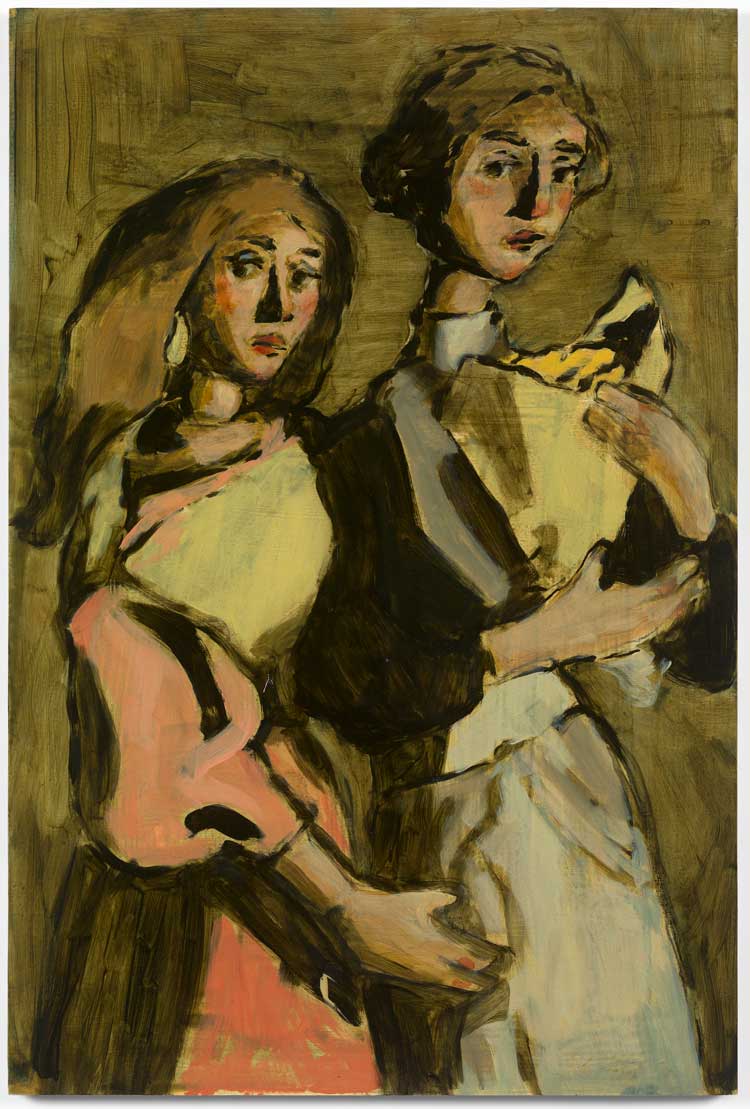
Liorah Tchiprout. Long is the day, and long is the night..., 2024. Oil on panel, 92 x 61 cm (36 ¼ x 24 in). Courtesy the artist and Pippy Houldsworth Gallery, London. © Liorah Tchiprout 2024. Photo: Todd-White Art Photography.
JL: Your work also abounds with literary references. How do you translate your interest in words to visual art?
LT: I think if I was more articulate, I would be a writer. And I think there’s something in pictures that you aren’t really allowed to do so much in writing, which is to create an image which implies but never substantiates a story. But I think that a lot of my work is made in response to literature. Not in a kind of direct, illustrative way, but more that the feeling or the soul of something really informs the work and what it’s about.
JL: Your paintings have beautiful titles, often taken from female Yiddish poets and novelists.
LT: I save a lot of things, I write a lot of things down. In my room as a teenager, I would write on the wall a lot. It had all those quotes on it, bits of songs. And outside of their context, in isolation, they become something else. Sometimes, they’re just from things people have said. There’s a kind of universality, where even if you don’t know the specific reference – and sometimes they are so personal that no one would know – a title can reflect a universal feeling.
Titles at first very much confused me because I thought it had to be something like “Doll One”, “Doll Two”. But then I realised that, especially with etching, because on the front of an etching you have a space for the title, titling was an invitation to say something with a sentence. It’s like someone briefly holding a microphone to your mouth. And I like to use that as a space to think more about the interior life of the dolls.
JL: Your works resemble portraits, but they largely depict dolls. Why?
LT: Before I started making them, I used to draw a lot from life. When I was drawing as a child and teenager, it wasn’t from imagination, it was from looking. I was really obsessed with the way that you catch a likeness of somebody. The real kind of driver was the likeness of people. Then, when I was doing my degree, you picked a module from a different department, and I picked puppets and I started researching about Zuni Maud, a Yiddish puppeteer in the 1920s. He used puppets, which were traditionally a gentile medium, and infused them with Yiddish folk tales and political satire. And I just thought these were really cool.
The first dolls I made were a minyan – 10 men praying. And then making some drawings from them. From that, I started to make puppets and dolls to draw from.
JL: How do you make them?
LT: There are different generations of them. There were times when I made a lot with bottles, and then I made my own wire structure. Then I thought I would be very clever and put them on existing wooden maquette things, but that is really bad. You get way more movement, such as the intonation of the head, which is lovely. But they break very easily and there’s no way of repairing them. It works, the layers of disintegration. They’re made in a way a child would make them, they’re not very sophisticated. I used to save my hair for them, but then I found people on Etsy who sell more realistic-looking hair that falls directly. And as I was working on them, there became a consideration of knowing the shorthand I use in painting. Everything that needs to be there is there, and everything that does not is not.
They’re very special to me, I like to keep them safe and looked after. Even if they are retired. There are some that have been used very little. This one is a little girl but she’s not used much yet.
JL: Are they all distinctive characters?
LT: Yes. Well, some of them are remakes of older characters. This is Princess. I wanted to update her, so I thought of Grace Kelly of Monaco, and made a dress for her inspired by Kelly. I was going to cut her hair like Kelly, too, but then I loved the long flowing hair. This is one based on a friend of mine from school, Emily, who is an illustrator. She had long hair that went to her feet. I asked her if I could have it if she ever cut it. So, she gave it to me. The doll is based on Emily, but she’s also Rapunzel, the maiden in the tower.
This one is a real person, Els Keezer, who was murdered in the Holocaust. She was a dancer. She featured on the documentary My Family, the Holocaust and Me with Robert Rinder. I was watching it and thought I would love to make a doll of her. But then, by really weird coincidence, her family contacted me and asked me if I did commissions and would I make some work of Els. I said yes, if I could make a doll, and subsume her into this sort of pseudo-pantheon of dolls. And they said yes.
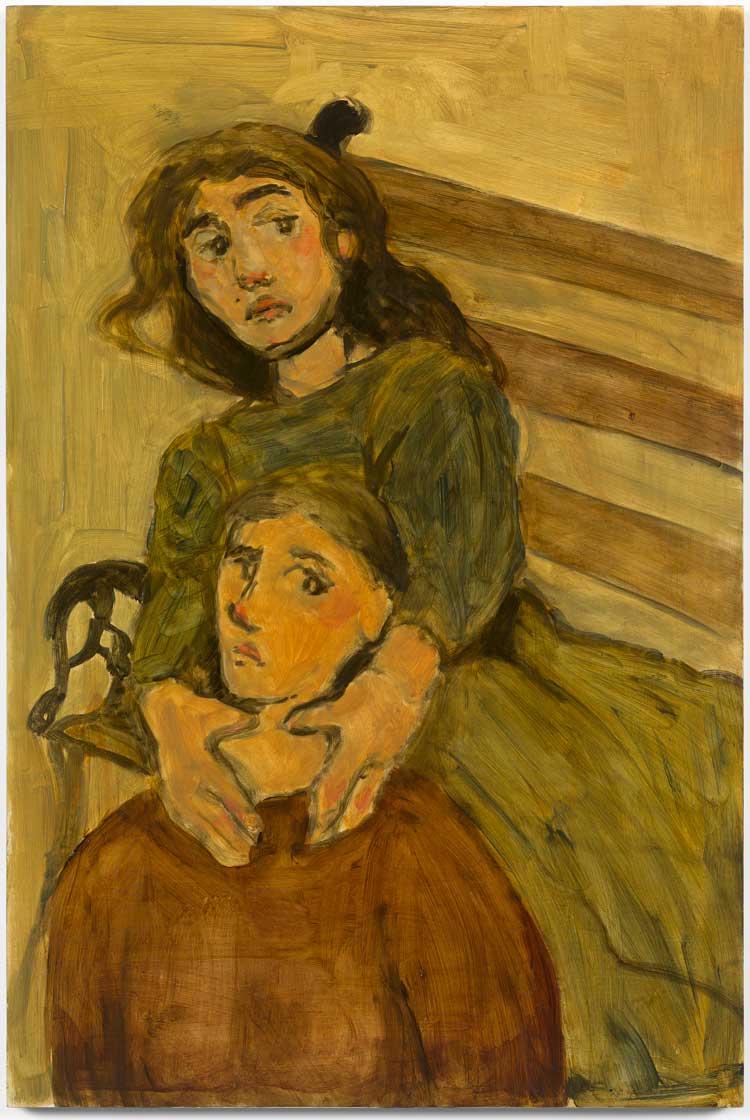
Liorah Tchiprout. The night would see me awake, 2024. Oil on panel, 92 x 62 cm (36 ¼ x 24 ½ in). Courtesy the artist and Pippy Houldsworth Gallery, London. © Liorah Tchiprout 2024. Photo: Todd-White Art Photography.
JL: Your dolls seem to exist in a largely female world?
LT: Yes, but then there are some who end up becoming male. They kind of morph. This used to be a Pierrot with a ruff, but often she ends up morphing into being other people or real people. This is from a previous show that doesn’t look like her at all, it looks like a man. But I do think of it as a woman’s world, where the men are unseen, they’re off.
JL: There is a sort of modesty to them, with large dresses and androgynous clothes.
LT: I think a lot of contemporary figuration about womanhood is also about sex and desire in an overt way. My work is quite a bit about longing and heartbreak, but I’m interested in the idea that sex and violence can be applied off stage, off narrative. Just meditating on a look or a glance or an intonation, a bend of a head. I love work that’s very sensual, but that is not something that I’m interested in in my work at the moment.
When I was studying at Brighton, I spent a lot of time at the Chabad house. It was really, deeply inspiring. They had loads of cute kids, loads of lovely food. I was very close to the rabbi’s wife. I really enjoyed it when they said they would come to my show. And the idea of creating work that could make you feel without them being overly about sex and violence. Something that a religious woman can engage with as much as a secular person can. So, my work seems a bit of a pushback against the idea that everything has to be more overtly about sexuality.
JL: Your paintings create such sympathy for inanimate things.
LT: It’s like what I was saying about the kingdom of lies. But it’s not, a lie makes it sound like it doesn’t come from the heart. A lie sounds like it seeks to deceive in a negative way. But I think it’s how I can make the most direct line to the human heart that I can through colours and shapes on a bit of wood. There’s something about that as a pursuit in life that can hold you in such focus because it’s like stardust.
• Liorah Tchiprout: I Love the Flames, But Not the Embers is at Pippy Houldsworth Gallery, London, until 28 September 2024.
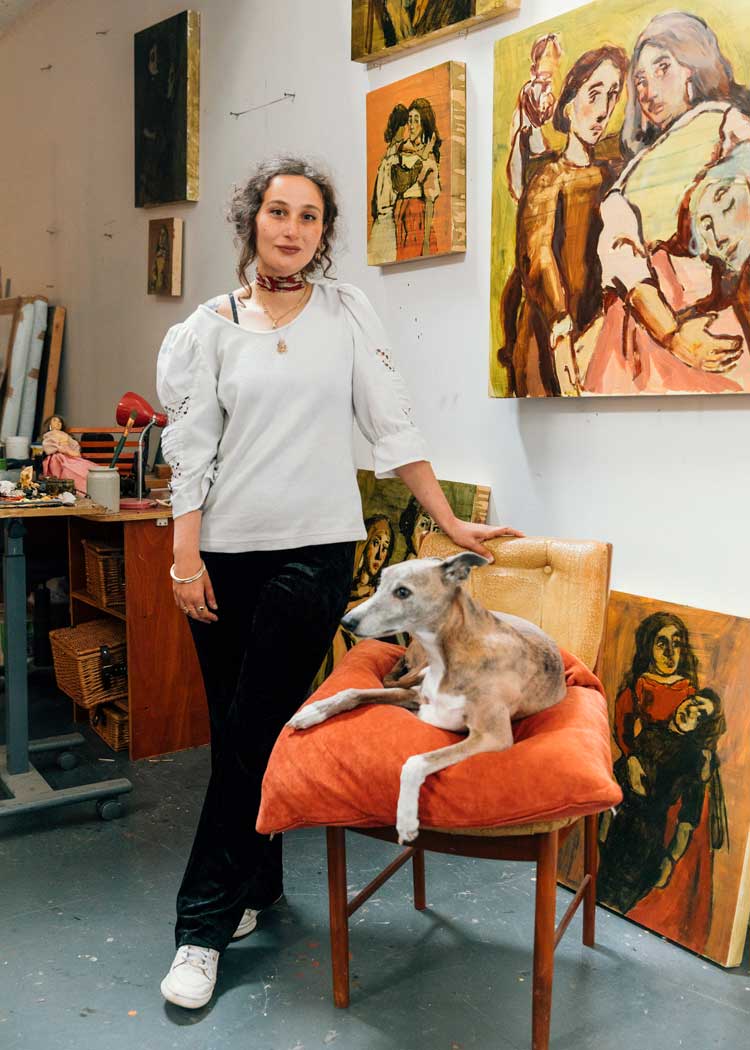
Liorah Tchiprout in her studio, 2024. Courtesy of the artist and Pippy Houldsworth Gallery, London. Photo: Sam Hylton.
Click on the pictures below to enlarge